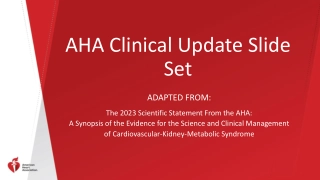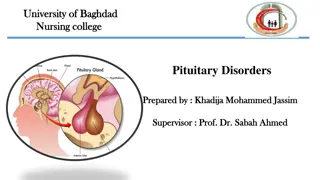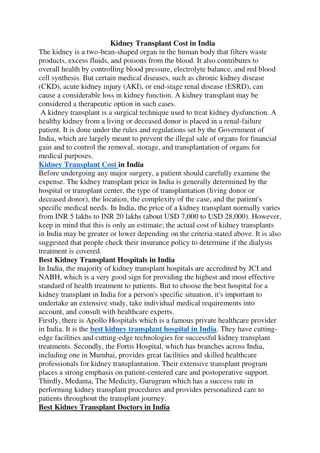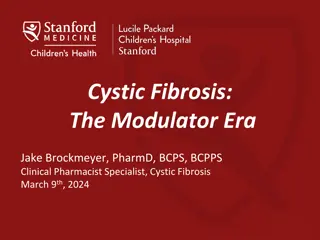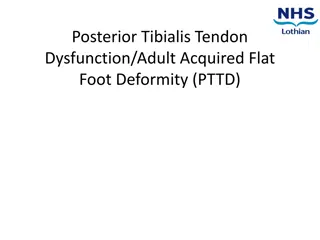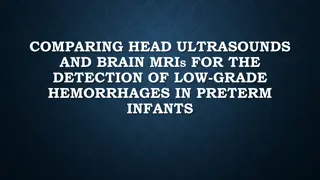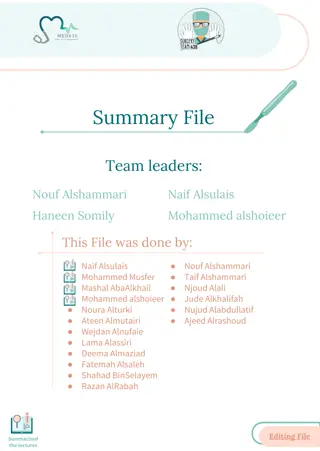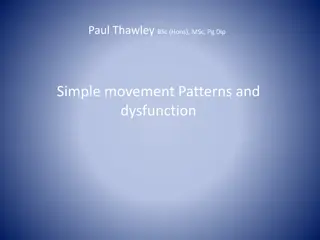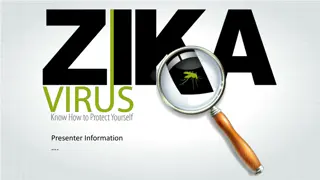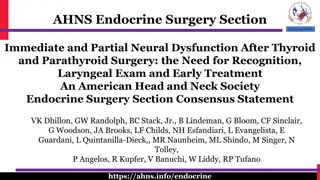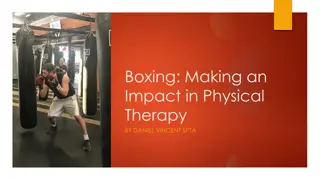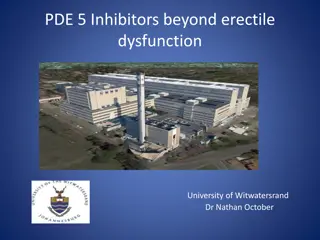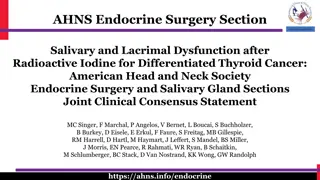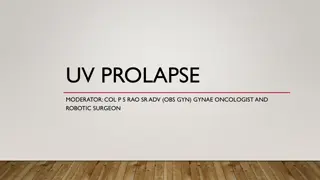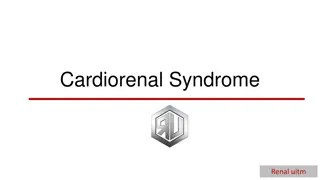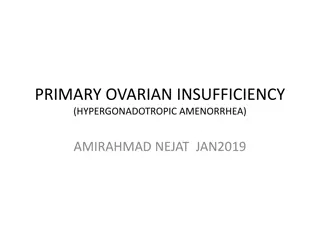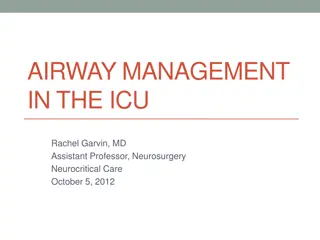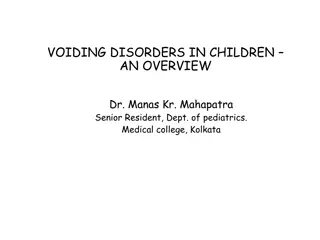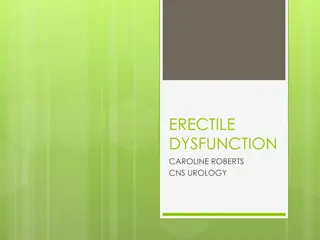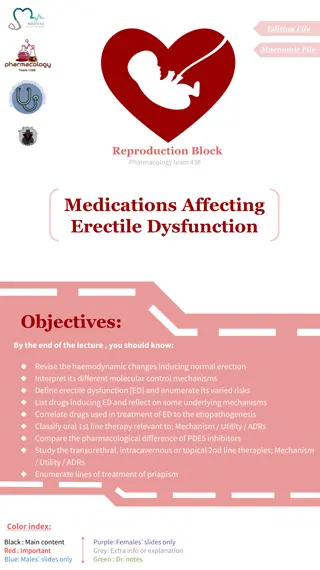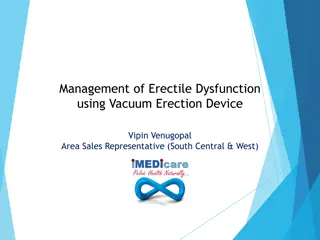Neurologic Disorder
Structural divisions of the central and peripheral nervous systems, learn about neuron anatomy, the neuromuscular junction, and the role of neurotransmitters. Includes information on Acetylcholine, Norepinephrine, Dopamine, and Serotonin.
0 views • 24 slides
AHA Clinical Update Slide Set
The evidence-based science and clinical management of Cardiovascular-Kidney-Metabolic Syndrome (CKM) in this comprehensive slide set. Learn about the pathophysiological interactions, multi-organ dysfunction, and adverse cardiovascular outcomes associated with CKM.
0 views • 14 slides
Cardiovascular Disease in HIV
The increased risk of cardiovascular disease in people with HIV and specific strategies to treat it. This presentation discusses potential mechanisms, comorbidity gaps, and the impact of traditional risk factors. Explore the role of inflammation and immune dysfunction in atherosclerosis and vulnerab
0 views • 38 slides
Pituitary Disorders
Pituitary disorders, often caused by tumors, can disrupt hormone production leading to various symptoms like weight gain, vision problems, and hormonal imbalances. The pituitary gland plays a crucial role in regulating bodily functions through hormone secretion. Factors such as tumor growth, head in
0 views • 25 slides
Evolution in HDL Hypothesis: CSL-112 Infusions in Acute Myocardial Infarction
This study explores the use of CSL-112 infusions in patients with acute myocardial infarction to enhance high-density lipoprotein (HDL) function. By focusing on improving HDL-C function through ApoA-1 infusions, the research aims to enhance outcomes associated with cardiovascular events. The efficac
4 views • 27 slides
Kidney Transplant Cost in India
The kidney is a two-bean-shaped organ in the human body that filters waste products, excess fluids, and poisons from the blood. It also contributes to overall health by controlling blood pressure, electrolyte balance, and red blood cell synthesis. But certain medical diseases, such as chronic kidney
10 views • 2 slides
Cystic Fibrosis:The Modulator Era
Cystic Fibrosis (CF) is a genetic disease caused by variants in the CFTR gene. CFTR is a crucial membrane protein responsible for chloride transport in epithelial cells, impacting organ function. The Modulator Era focuses on CFTR modulators approved by the FDA for treating CF and improving outcomes.
0 views • 63 slides
Posterior Tibialis Tendon Dysfunction (PTTD) in Adults
Posterior Tibialis Tendon Dysfunction, also known as Adult Acquired Flat Foot Deformity (PTTD), is a condition that affects the tibialis posterior tendon, leading to reduced arch support. Common causes include obesity, trauma, age, and existing health conditions. Symptoms may include ankle pain, swe
0 views • 12 slides
Sexual Dysfunction and Associated Factors
Sexual dysfunction encompasses a range of issues that can affect individuals, with causes including psychological, neurological, hormonal, and relationship-related factors. Evaluating sexual problems involves considering duration, context, and frequency. Psychological causes, such as anxiety and str
0 views • 25 slides
Sacroiliac Joint Dysfunction: A Comprehensive Guide
Discover the intricate anatomy of the spine, learn about the prevalence and causes of lower back pain, delve into the symptoms and diagnosis of sacroiliac joint dysfunction, and explore treatment options to manage this condition effectively.
0 views • 27 slides
Detection of Low-Grade Hemorrhages in Preterm Infants: Ultrasounds vs. MRIs
This study compares the effectiveness of head ultrasounds and brain MRIs in detecting low-grade hemorrhages in preterm infants. It discusses the incidence of intraventricular hemorrhage (IVH) in very low birth weight infants, classification of IVH, risk factors for IVH, outcomes related to IVH grade
9 views • 33 slides
Overview of Trauma Management in the Emergency Department
This summary file covers the key aspects of trauma management, including epidemiology of trauma, mechanisms of injury (penetrating and blunt), triage and severity scoring, primary survey with ABCDE approach, emergency department management per ATLS protocol, and adjuncts to primary survey. It emphas
0 views • 42 slides
Strategic Innovation in Emergency Care Research Network (SIREN)
SIREN is a collaborative network enabling high-quality, multi-site clinical trials for patients with neurologic, cardiac, respiratory, hematologic, and trauma emergencies. It consists of Clinical Coordinating Center, Data Coordinating Center, and 11 Clinical Centers with affiliated satellites. The n
1 views • 12 slides
Neonatal Seizures and Their Pathophysiology
Neonatal seizures are sudden changes in neurologic function of a newborn, involving motor, behavior, and autonomic functions. The pathophysiology includes delays in Na/K ATPase maturation, increased receptor density, and GABAergic transmission. Different types of seizures like subtle, clonic, tonic,
1 views • 24 slides
Movement Dysfunction in Sports Medicine
Movement dysfunction in sports medicine can stem from various factors such as structural instability, loss of range of motion, functional rigidity, poor balance, and more. Clinical movement analysis plays a vital role in identifying muscle imbalances and guiding exercise interventions to enhance ath
0 views • 21 slides
Zika Virus: Risks and Precautions
Zika virus is a mosquito-borne infection that can lead to birth defects and neurologic disorders. It spreads through mosquito bites and can also be transmitted from mother to child during pregnancy or through sexual contact. The virus is prevalent in South and Central America, the Caribbean, and is
0 views • 17 slides
Executive Functioning and Executive Dysfunction
Executive Functioning is a key aspect of cognitive function, encompassing various abilities such as planning, self-awareness, and emotion regulation. Executive Dysfunction, often resulting from frontal lobe injuries, can lead to difficulties in decision-making, social interactions, and learning. Thi
1 views • 21 slides
Comprehensive Management of Head Injury: Overview and Key Strategies
Head injuries pose a significant threat to morbidity and mortality, with causes ranging from motor accidents to child abuse and falls. Understanding the epidemiology and pathophysiology of head injuries is crucial for effective management. Primary and secondary brain injuries necessitate immediate c
0 views • 42 slides
Ion Channel Dysfunction in Critical Illness
An intriguing case study presents a young male with weakness and coma in the ICU following pneumonia and sepsis. Nerve conduction results indicated critical illness myopathy and polyneuropathy, along with cardiac abnormalities. Reduced muscle excitability was attributed to a sodium channelopathy. Th
0 views • 14 slides
Vocal Fold Paralysis and Neural Dysfunction After Thyroid and Parathyroid Surgery
This consensus statement by the American Head and Neck Society Endocrine Surgery Section highlights the importance of recognizing immediate vocal fold paralysis (VFP) and partial neural dysfunction (PND) following thyroid and parathyroid surgery. The report emphasizes the need for early identificati
0 views • 17 slides
Addressing Cognitive Dysfunction in Patients with Cancer: Causes, Impact, and Treatment
Understanding cognitive dysfunction in cancer patients is crucial for improving quality of life and medical outcomes. This article explores the background, causes, screening, diagnosis, and treatment options for cancer-related cognitive impairment, emphasizing the historical perspective, prevalence,
0 views • 60 slides
The Impact of Boxing in Physical Therapy: A Non-Traditional Approach
Boxing is gaining popularity in physical therapy for addressing orthopedic and neurologic conditions. It offers benefits such as movement coordination, balance training, and confidence-building. Research indicates its effectiveness for conditions like cancer, stroke, multiple sclerosis, and Parkinso
0 views • 27 slides
Neonatal Seizures and Differentiating from Jitteriness
Neonatal seizures are a critical sign of neurologic dysfunction in newborns, with various types such as subtle, clonic, tonic, spasms, and myoclonic seizures. The immature brain's excitability and differences from the mature brain predispose neonates to seizures. Generalized clonic seizures are rare
0 views • 17 slides
Gilead-Supported Abstracts Published at CROI 2021: Treatment Updates and Lenacapavir Advancements
Abstracts from CROI 2021 selected by Gilead highlight treatment effects on neurologic outcomes, drug interactions, clinical trials of antiretroviral therapy, and new developments in drug resistance. Additionally, the session on Lenacapavir (GS-6207) presents promising data on this long-acting HIV ca
0 views • 13 slides
Diverse Applications of PDE-5 Inhibitors Beyond Erectile Dysfunction
Discover how PDE-5 inhibitors go beyond treating erectile dysfunction, with approved and emerging compounds, alternative dose regimens, concentration sites, and potential targets like cardiovascular diseases and the central nervous system.
0 views • 47 slides
Recognizing Warning Signs for High-Risk Drivers at Senior Driver Summit
In the Senior Driver Summit breakout session, Cody Stovall discussed the warning signs of high-risk drivers, emphasizing the importance of clinical driver assessments for older drivers. The program established in 1998 evaluates older drivers with cognitive decline, new drivers needing adaptations, a
0 views • 17 slides
Salivary and Lacrimal Dysfunction after Radioactive Iodine Treatment
Radioactive iodine (RAI) is commonly used in treating differentiated thyroid cancer but can lead to salivary and lacrimal dysfunction. This joint clinical consensus statement by the American Head and Neck Society Endocrine Surgery and Salivary Gland Sections highlights the importance of understandin
0 views • 20 slides
The MMPI-2-RF Substantive Scales for Mental Disorder Assessment
This research explores mapping the MMPI-2-RF substantive scales onto internalizing, externalizing, and thought dysfunction dimensions in mental health assessment. The study emphasizes the importance of validating assessments for accurate clinical pictures and effective treatment planning. It delves
0 views • 17 slides
Pelvic Floor Dysfunction and Prolapse in Women
Pelvic floor dysfunction and prolapse are common issues affecting women, impacting their physical and emotional well-being. Surgical treatment may be necessary for symptomatic cases, but a thorough evaluation of symptoms, obstetric history, and other factors is crucial. Addressing precipitating fact
0 views • 72 slides
Cardiorenal Syndrome: A Complex Relationship Between the Heart and Kidneys
Cardiorenal Syndrome is a condition where dysfunction in one organ, whether acute or chronic, can lead to dysfunction in the other. This complex relationship involves intricate communication pathways between the heart and kidneys, impacting hemodynamic stability, organ perfusion, and neurohormonal i
0 views • 15 slides
Coronavirus: Prevention and Safety Measures
Coronaviruses are single-stranded RNA viruses that infect birds, mammals, and humans. They can cause respiratory and enteric diseases, hepatitis, and neurologic issues. Initially of veterinary interest, coronavirus spread has escalated into human-to-human transmission. WHO recommends handwashing, co
0 views • 13 slides
Salivary Gustin and Taste Dysfunction in Long-COVID Patients
The research explores the association between taste perception and the duration of COVID infection in long-COVID and COVID-reinfection cases. Reduced salivary gustin levels correlated with lower taste scores in long-COVID patients. The study also found an increase in the bitter taste receptor gene e
1 views • 4 slides
Primary Ovarian Insufficiency: Definition, Pathophysiology, Clinical Features
Primary ovarian insufficiency, also known as hypergonadotropic amenorrhea, is a condition characterized by ovarian dysfunction in women under 40. It involves oligo/amenorrhea, elevated FSH levels, and impacts fertility and overall health. The pathophysiology includes follicle depletion and dysfuncti
0 views • 46 slides
Airway Management in the NeuroICU: Importance and Strategies
Understanding the crucial role of airway management in the NeuroICU is essential for preventing secondary brain injury and addressing respiratory complications in neurologically-injured patients. This presentation covers the significance of airways, common issues, evaluation techniques, adjuncts, an
0 views • 45 slides
Voiding Disorders in Children: An Overview by Dr. Manas Kr. Mahapatra
Voiding disorders in children, also known as bladder dysfunction, are a common issue affecting up to 40% of pediatric urology clinic visits. These disorders can indicate underlying pathophysiology requiring treatment to prevent renal or urologic damage. The development of urinary control by age 5 is
0 views • 53 slides
Thoracic Outlet Compression Syndrome
Thoracic Outlet Compression Syndrome is characterized by upper extremity pain and paresthesias due to vascular or neurologic compression at the thoracic outlet. Learn about its anatomical features, incidence, etiology, pathophysiology, clinical manifestations, and diagnosis.
0 views • 23 slides
ERECTILE DYSFUNCTION
Erectile dysfunction, often affecting 1 in 10 men, is the inability to achieve an erection adequate for sexual intercourse. This condition can be caused by various factors including physical, psychological, neurological, and vascular issues. Excessive drinking, smoking, heart and vascular diseases,
0 views • 21 slides
Medications for Erectile Dysfunction Overview
This content covers the mechanisms of normal erection, erectile dysfunction, drugs causing ED, treatment options, and classification of therapies for ED. Explore the haemodynamic changes, molecular control, risks, and more related to ED medications.
0 views • 11 slides
Management of Erectile Dysfunction using Vacuum Erection Device
Erectile Dysfunction (ED) is a prevalent condition affecting millions of men globally. This article discusses the commonality of ED, its impact on quality of life, causes, and treatment options including vacuum erection devices and other medical interventions. It emphasizes the importance of address
0 views • 14 slides
Understanding Erectile Dysfunction: Mechanisms, Treatment, and Pathophysiology
Erectile dysfunction (ED) is a common condition that affects many men. Explore the haemodynamic changes and molecular control mechanisms involved in normal erection, understand the risks and underlying mechanisms of ED, and discover treatment options including pharmacological differences of PDE5 inh
0 views • 17 slides

